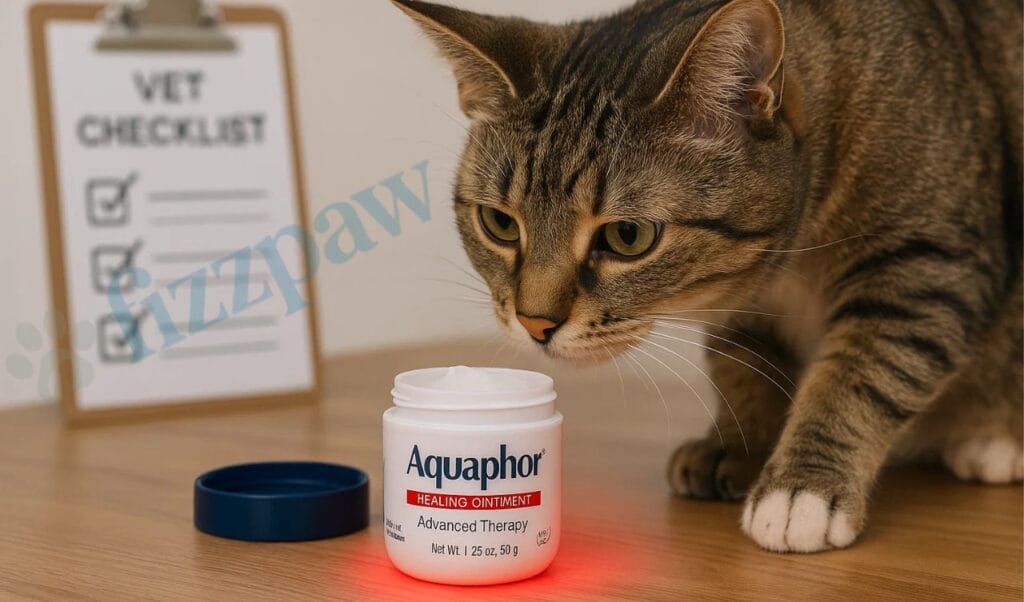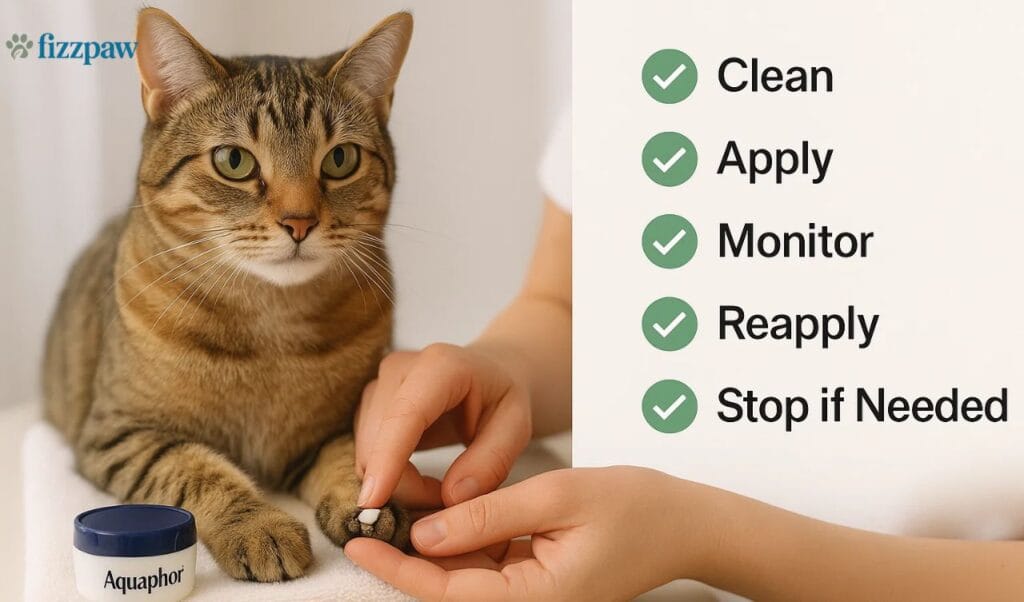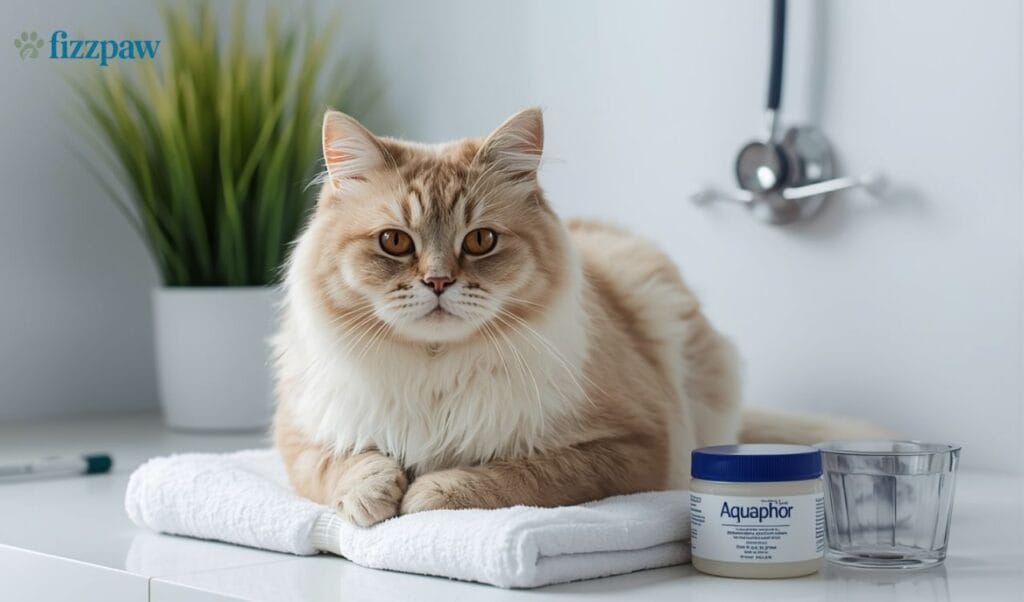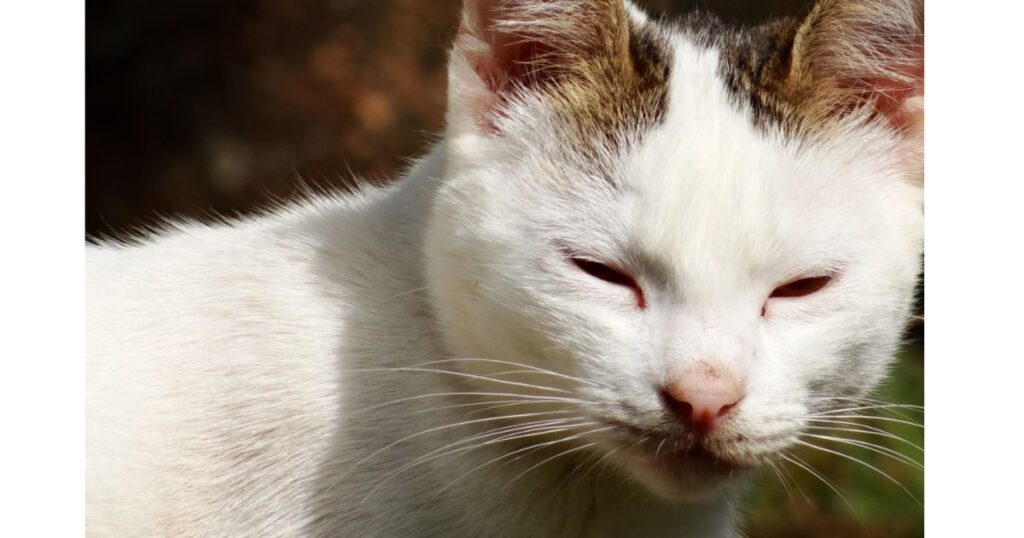Cats are susceptible to dry skin, minor cuts, scabs and itchy patches, just like human beings. It’s the reason pet owners inquire, “Can I put Aquaphor on my cat?” This is a very common question, particularly for U.S. cat owners who depend on Aquaphor to get their skin-care needs.
In this complete guide, we’ll go over the basics of what Aquaphor is, whether it’s suitable for felines, as well as the dangers that come with using it the safer alternatives, as well as natural tips for skin care to ensure your cat is well-groomed and comfy.
What Is Aquaphor and Why Do Pet Owners Use It?
Aquaphor is a well-known Ointment to heal dry lips, chapped skin, cracked heels, chapped lips and minor wounds. It’s made of petroleum jelly, mineral oil, alcohol, lanolin and glycerin. They create a barrier to seal in moisture and aid in healing.
Pet owners often ask, ‘Can I put Aquaphor on My Cat?’ because they notice dry paws, broken noses, or other minor skin problems. However, what’s effective for humans might not be suitable for cats. Since cats are constantly licking themselves, they can take the ointment and swallow it, which is why vets advise against its use for pets.
Why Pet Owners Reach for Aquaphor
Here are the main reasons cat owners try Aquaphor:
- Dry or cracked paw pads (from rough floors, cold weather, or allergies).
- Dry cat nose remedy when their cat’s nose looks flaky.
- Scratches or scabs where the skin looks irritated.
- To acts as a moisturizing cream when cats suffer from skin irritation or allergies.
| Aquaphor Benefits (for Humans) | Why Pet Owners Consider It for Cats |
| Soothes dry, cracked skin | Dry or cracked paw pads in cats |
| Protects against moisture loss | Dry cat nose or flaky ears |
| Speeds up minor wound healing | Cat scratches or scabs |
| Provides a skin barrier | To prevent cats from over-licking |
Is Aquaphor Safe for Cats?

The simple solution is that Aquaphor can be harmful for cats in small quantities. However, it’s not completely safe for cats. When considering ‘Can I Put Aquaphor on My Cat,’ always remember that cats groom themselves, which increases the risk of ingestion. Here’s why:
Aquaphor is primarily made from petroleum jelly as well as other components like mineral oils, lanolin alcohol and Glycerin. None of them is considered poisonous for cats, even in small doses. If your cat bites tiny amounts of Aquaphor from their nose or paw, the liquid will generally go through their digestive system but not cause any serious harm.
But the issue can be that felines groom themselves regularly. So, every Aquaphor that you put on your cat’s fur or skin is likely to be removed. Consuming large amounts of it could cause digestive issues, for example:
- Drooling
- Vomiting
- Diarrhea
- Stomach discomfort
Another problem is that Aquaphor is extremely sticky and oily, and once it is applied, it can attract dirt, dust and hair. This can cause your cat’s skin conditions to become worse rather than better.
Also Read: How Can I Soothe My Cat’s Itchy Skin
Veterinary Opinion
Veterinarians generally do NOT generally recommend Aquaphor to cats. Although it is safe for humans and, occasionally, pets; However, felines are more sensitive due to:
- Cats love to lick their body more frequently than dogs, and have a higher chance of ingestion.
- Feline digestive systems are different → they may react badly even to small amounts.
Risks of Using Aquaphor on Cats
While Aquaphor is not toxic in small amounts, using it on cats carries several hidden risks. A major concern for cat owners is whether Aquaphor on My Cat could cause digestive problems if ingested. Cats are very sensitive animals, and what works for human skin does not always suit feline skin. Below are the most important risks every cat parent should know before applying it.
1. Constant Licking and Ingestion
Cats groom themselves at least once throughout the day. When you put Aquaphor on the cat’s paws, nose or skin, they are likely to be able to lick it off. Cats love to lick everything that they apply to their skin. If they inhale Aquaphor, it may cause stomach upset, vomiting, diarrhea, or even drooling.
Fact: According to the ASPCA Animal Poison Control Center, petroleum jelly is considered low toxicity, but it may still lead to digestive upset in cats if swallowed.
Also Read: Natural Remedies for Cat Diarrhea
2. Greasy Build-Up
Its thick texture holds dirt, dust and hair, preventing the flow of blood to your skin and slowing healing — rendering the product less efficient than the pet-safe balms.
3. Allergic Reactions
Cats may react to ingredients such as the lanolin ingredient, which can cause itching, redness or bumps, particularly in the case of skin allergies.
4. False Sense of Safety
Since Aquaphor is safe for humans, many believe it’s suitable for cats. However, it could mask issues such as allergies or infections and delaying proper treatment for vets.
Table: Comparing Aquaphor vs. Cat-Safe Alternatives
| Feature | Aquaphor | Pet-Safe Balms/Lotions |
| Main Use | Human dry skin & minor wounds | Formulated for cats’ skin health |
| Safety | Not toxic in small amounts, but risky | Safe for licking and grooming |
| Texture | Thick, greasy, attracts dirt | Light, natural, absorbs easily |
| Ingredients | Petroleum jelly, mineral oil, lanolin | Coconut oil, shea butter, vitamin E oil |
| Vet Recommendation | Not advised for cats | Strongly recommended |
When (and Where) Aquaphor May Be Used on Cats
While Aquaphor isn’t advised as a typical cat skin care product, there are some specific situations in which a vet could recommend it. The trick is to know the best time, place and how to apply it properly and when to stay clear of the use completely.
- Dry paw pads or nose: A tiny amount can help with mild dryness, especially in winter.
- Hard-to-reach areas: Such as the outer ear flap or a dry patch on the back, where your cat can’t easily lick.
- Not for wounds: Never use on cuts, infections, or surgical sites—it can trap bacteria.
- Short-term only: Best as a quick fix while waiting for vet care, not a daily routine.
- Monitor closely: Stop immediately if your cat shows signs of licking, drooling, vomiting, or skin irritation.
- Not for wounds: Never use on cuts, infections, or surgical sites—it can trap bacteria. According to the American Veterinary Medical Association’s wound care guidelines, pets should only receive treatments specifically approved for animals.
Aquaphor might assist with dryness in the minor sense; however, it’s not an effective solution for long-term dryness. Always search for pet-safe alternatives for frequent usage.
Also Read: Best Cat Food for Skin Allergies
Example Scenario Where Vets Might Allow It:
Your cat is prone to dry paw pads in winter. Apply a small amount of Aquaphor, then rub it into the area thoroughly, and then distract your cat by playing with toys until it completely absorbs. It is usually secure; however, continuous application is not recommended.
Safer Alternatives to Aquaphor for Cats
Aquaphor isn’t made for cats, but these vet-approved alternatives are safer and more effective:
- Pet-Specific Ointments – Products like Vetericyn Plus or Zymox Cream are made for animals and are safe if licked.
- Coconut Oil – Natural moisturizer with antibacterial properties; safe in small amounts. Related Article: Can I Put Coconut Oil on My Cat’s Bum
- Pet Paw & Nose Balms – Musher’s Secret or Burt’s Bees for Cats protect dry paw pads and noses.
- Pet-Safe Aloe Vera Gel – Soothes irritation, but ensure it’s free of toxic aloin.
- Omega-3 Supplements – Improve skin health from the inside out.
Always pick cat-safe products instead of Aquaphor to keep your pet safe and comfortable.
Step-by-Step Safety Guide If You Still Use Aquaphor

If you decide to use Aquaphor on your cat, follow these steps carefully:
- Clean the Area – Gently wash with warm water and dry.
- Apply a Tiny Amount – Use only a thin layer on the spot (nose, paw, or small wound).
- Distract Your Cat – Play, feed, or cuddle to stop immediate licking.
- Monitor Closely – Watch for signs of licking, drooling, or stomach upset.
- Reapply Only if Needed – Do not overuse.
- Stop if Problems Appear – Redness, vomiting, or diarrhea means contact your vet.
Tip: Aquaphor should be a last resort, not a daily product. Always ask your vet first.
Signs You Should Stop and Call the Vet
Even if you are using Aquaphor or any other pet-safe option cautiously, there will be times when your cat’s skin or behavior could indicate that something is more severe. Cats are excellent in spotting discomfort, and being aware of the following warning signs could be the key to determining.
- Worsening irritation – redness, swelling, or bleeding that doesn’t improve in a few days.
- Allergic reactions – hives, rash, drooling, vomiting, or swelling of the face/eyes.
- Ingestion issues – greasy stools, upset stomach, or unusual tiredness after licking.
- Infection signs – pus, foul odor, oozing wounds, or fever-like behavior (low energy, no appetite).
- Behavioral changes – hiding, over-grooming, or refusing food/water.
If you see any of these, stop using Aquaphor immediately and call your vet. Cats often need medical care for skin issues, not just ointment.
Tips for Maintaining Healthy Cat Skin Naturally
Cats thrive when their skin and coat are cared for from the inside out. Instead of waiting until dryness, irritation, or allergies appear, you can support your cat’s skin health through nutrition, grooming, gut health, and environment. Here’s how:
- Feed a balanced diet: High-quality protein and omega-3/6 fatty acids (fish, poultry) keep skin and coat strong.
- Groom regularly: Brushing spreads natural oils, prevents dandruff, and reduces matting.
- Hydrate well: Provide fresh water or a cat fountain; wet food also adds moisture.
- Improve environment: Use a humidifier in dry homes, reduce allergens, and prevent fleas/mites.
- Try gentle natural aids: Small amounts of coconut oil, pure aloe vera gel, or calendula spray (vet-approved).
- Minimize stress: Playtime and enrichment reduce overgrooming from anxiety.
- Vet checkups: Routine exams catch allergies, parasites, or skin issues early.
Nutrition, grooming, hydration, and a safe environment are the best ways to keep your cat’s skin naturally healthy.
Frequently Asked Questions (FAQs)
Can you put Aquaphor on a cat?
It’s not recommended—cats lick it off, which may cause stomach upset.
Is it okay for cats to lick Aquaphor?
No. Licking can lead to vomiting or diarrhea; safer alternatives are better.
Is Aquaphor animal safe?
It’s not toxic but also not pet-safe—use products made for animals instead.
Is Aquaphor just Vaseline?
No. Aquaphor contains petroleum jelly plus other ingredients like mineral oil and lanolin.
Is it safe to lick Aquaphor?
For humans, small amounts are harmless, but for cats, licking can cause digestive upset.
Final Thoughts: Should You Use Aquaphor on Cats?
Aquaphor is a great choice for humans; however, it’s not the most secure option for cats. While it’s not poisonous, the danger comes from the possibility of stomach upset, licking and even infections when placed on wounds.
If your cat is suffering from dry cracks on its paws, dry skin, as well as hot spots, it’s better to choose vet-approved and pet-safe options. In conjunction with a nutritious diet, grooming routine, and proper hydration, the skin of your cat will remain healthy and beautiful without the risk of using harmful products.




